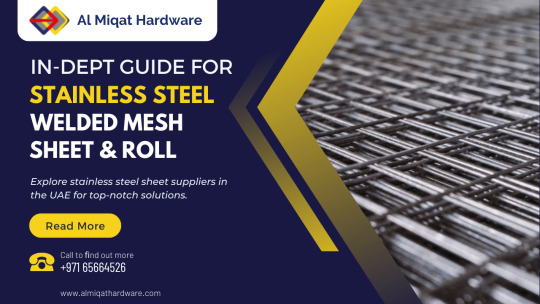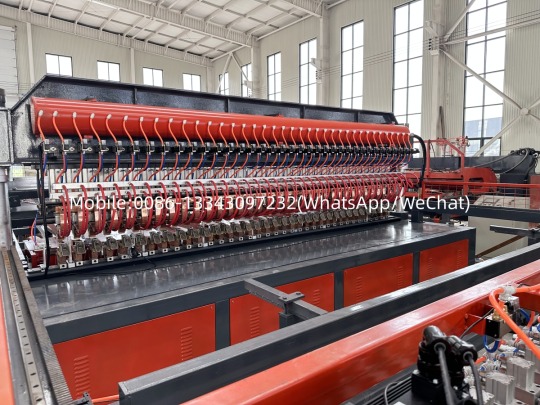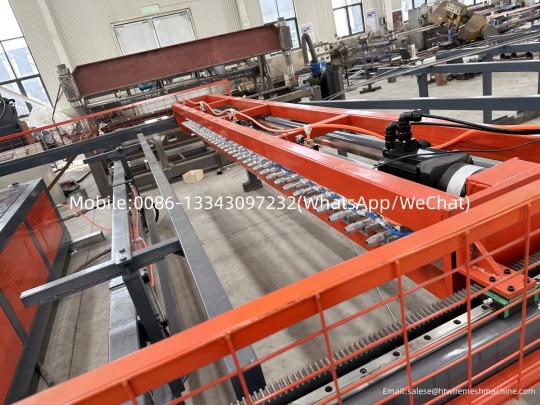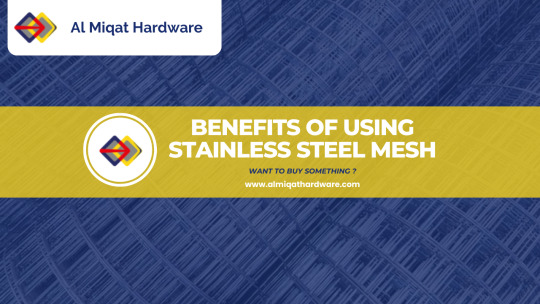#welded wire mesh
Text
#welded wire mesh#welded wire mesh fence#welded wire mesh rolls#welded mesh manufacturers#welded wire mesh sizes#welded wire mesh price#welded wire mesh suppliers near me#chain link wire mesh#chain link wire mesh manufacturers in Madurai#architecture#business
2 notes
·
View notes
Text
A Comparative Analysis of GFRP Mesh and Welded Wire Mesh in Building Slabs
In contemporary construction, concrete, while exhibiting exceptional compressive strength, necessitates reinforcement to address its inherent brittleness and limited tensile capacity. This reinforcement mitigates cracking and enhances the overall structural integrity of concrete slabs. Two prevalent reinforcement materials employed in this context are glass fiber reinforced polymer (GFRP) mesh and welded wire mesh. This analysis delves into a meticulous comparison of their performance characteristics within the domain of building slab applications.

Material Composition and Properties
GFRP Mesh: Composed of interwoven glass fibers meticulously embedded within a polymer resin matrix, GFRP mesh boasts a lightweight and inherently non-corrosive nature. The glass fibers imbue the mesh with superior tensile strength, while the polymer resin effectively binds the fibers and shields them from environmental degradation.
Welded Wire Mesh: A traditional and widely utilized reinforcement option, welded wire mesh is crafted from steel wires electrically welded at their intersection points. This configuration offers commendable tensile strength and facilitates effective integration with concrete. However, steel's susceptibility to corrosion poses a significant challenge, particularly in environments characterized by high moisture content or exposure to salt.
Performance Evaluation
Strength and Crack Management
Tensile Strength: GFRP mesh demonstrates a higher tensile strength compared to standard welded wire fabric mesh. This translates to superior crack control capabilities within concrete slabs subjected to tensile forces.
Flexural Strength: While welded wire mesh generally exhibits a higher flexural strength than GFRP mesh due to steel's superior bending resistance, for building slabs designed within their designated load limits, both materials can provide adequate flexural strength.
Bond Strength with Concrete: The surface texture of GFRP mesh can be specifically engineered to enhance its bond strength with concrete. However, meticulous surface preparation for both materials remains paramount for optimal performance.

Durability and Corrosion Resistance
Corrosion Resistance: GFRP mesh offers a clear and compelling advantage in this domain. Its inherent non-corrosive nature makes it the material of choice for environments with high moisture content, exposure to salt or aggressive chemicals. Conversely, the steel in welded wire mesh is susceptible to rust, which can initiate concrete degradation and ultimately lead to structural weakening.
Fatigue Resistance: GFRP mesh exhibits demonstrably superior fatigue resistance compared to welded wire mesh. This characteristic proves particularly beneficial in applications where the concrete slab experiences repeated cycles of loading and unloading.
Weight Management and Handling
Weight: GFRP mesh boasts a significantly lower weight than its welded wire mesh counterpart. This translates to demonstrably easier handling, transportation and installation, leading to reduced labor costs and enhanced construction efficiency.
Design Considerations and Cost Implications
Design: Established design procedures for both materials are typically incorporated within building codes. However, engineers may need to account for the lower flexural strength of GFRP mesh by strategically adjusting slab thickness or incorporating supplementary reinforcement in specific scenarios.
Cost: While GFRP mesh offers undeniable advantages such as superior corrosion resistance and weight reduction, it can incur a higher upfront cost compared to standard welded wire mesh price. However, this initial cost differential can be effectively mitigated by factoring in reduced labor costs due to easier handling and potentially lower long-term maintenance requirements in corrosive environments.
Applications
GFRP Mesh: GFRP mesh shines in applications where exceptional corrosion resistance is a paramount concern. These include building slabs exposed to de-icing salts, marine environments, or areas characterized by high humidity. Additionally, its lightweight nature makes it particularly suitable for prefabricated concrete elements and situations where weight reduction is a crucial design consideration.
Welded Wire Mesh: Welded wire mesh remains a cost-effective and widely used option for standard building slabs constructed in controlled environments. Its high flexural strength can be advantageous in specific slab design scenarios.

Additional Considerations for Informed Decision-Making
Fire Performance: Both GFRP mesh and welded wire mesh exhibit a propensity to lose some strength when exposed to high temperatures. However, specific fire-rated GFRP mesh options are available that can meet the requisite building code requirements for fire resistance.
Sustainability: GFRP mesh can be a more sustainable choice in certain situations, particularly when considering its extended service life and potentially lower long-term maintenance needs.
The Rise of GFRP Mesh in Building Slab Reinforcement
The optimal selection between GFRP mesh and welded wire mesh for building slab reinforcement hinges upon the specific project requirements and established priorities. GFRP mesh from Shri Rathi Group 7 STAR Advanced offers superior corrosion resistance and a significantly lower weight along with a competitive cost when compared to weld mesh price, making it the ideal choice for specific applications.
0 notes
Text
A welded mesh fence, also known as a welded wire mesh fence or welded panel fence, is a type of fencing system constructed using welded wire mesh panels.
0 notes
Text
Durable Welded Wire Mesh: Versatile Solutions for Construction and Agriculture
Welded wire mesh is a sturdy grid-like structure made by welding steel wires together at intersections. Used extensively in construction for reinforcement, fencing, and partitioning, it offers strength, durability, and easy installation. In agriculture, it's employed for animal enclosures and plant support.

0 notes
Text

Introduction to Stainless Steel Welded Mesh:
Stainless steel welded mesh is a versatile material made from stainless steel wires that are welded together to form a grid pattern. It is known for its strength, durability, corrosion resistance, and aesthetic appeal. Stainless steel welded mesh finds applications in various industries, including construction, agriculture, architecture, and manufacturing.
Types of Stainless Steel Welded Mesh:
Material Grade: Stainless steel welded mesh is available in different grades of stainless steel, including 304, 316, and 316L, each offering varying levels of corrosion resistance and mechanical properties.
Wire Diameter and Mesh Size: Stainless steel welded mesh comes in a range of wire diameters and mesh sizes to suit different applications. Common wire diameters range from 1mm to 5mm, while mesh sizes vary from small openings suitable for filtration to larger openings for fencing and reinforcement.
Surface Finish: Stainless steel welded mesh can have different surface finishes, including plain (unfinished), galvanized, or powder-coated, providing additional protection against corrosion and enhancing aesthetics.
Applications of Stainless Steel Welded Mesh:
Security Fencing: Stainless steel welded mesh is commonly used for security fencing in residential, commercial, and industrial properties due to its strength, durability, and resistance to cutting and vandalism.
Animal Enclosures: Stainless steel welded mesh is ideal for constructing animal enclosures, such as aviaries, animal cages, and kennels, providing a secure and durable barrier while allowing for visibility and airflow.
Reinforcement: Stainless steel welded mesh is used as reinforcement in concrete structures, such as slabs, walls, and foundations, to improve tensile strength, prevent cracking, and enhance structural integrity.
Filtration and Screening: Stainless steel welded mesh with fine mesh sizes is used for filtration and screening applications, such as water filtration, air vents, sieving, and insect screens, due to its corrosion resistance and precise openings.
Decorative Applications: Stainless steel welded mesh is utilized in architectural and interior design for decorative purposes, including balustrades, partitions, wall cladding, and artistic installations, providing a modern and sleek aesthetic.
Installation and Maintenance:
Installation: Stainless steel welded mesh can be installed using various methods, including welding, bolting, or clamping, depending on the application and structural requirements. Proper installation techniques ensure stability, security, and longevity of the mesh.
Maintenance: Stainless steel welded mesh requires minimal maintenance due to its corrosion-resistant properties. Regular cleaning with mild detergent and water can help remove dirt, debris, and surface contaminants, preserving its appearance and performance over time.
Safety Considerations:
Handling: When handling stainless steel welded mesh, wear appropriate personal protective equipment, such as gloves and eye protection, to prevent injury from sharp wire edges.
Welding: If welding stainless steel welded mesh, follow proper welding procedures and ventilation measures to minimize exposure to fumes and ensure weld quality and integrity.
Sourcing Stainless Steel Welded Mesh:
Supplier Selection: Choose reputable suppliers or manufacturers of stainless steel welded mesh with a proven track record of quality products, reliable service, and adherence to industry standards and specifications.
Customization: Many suppliers offer customization options for stainless steel welded mesh, including custom sizes, configurations, and finishes, to meet specific project requirements and preferences.
By following this guide, you can gain a comprehensive understanding of stainless steel welded mesh sheets and rolls, including their types, applications, installation, maintenance, safety considerations, and sourcing options, enabling you to make informed decisions for your projects or applications.
#wire mesh#oman business#sharjah#galvanized#stainless steel wire mesh#welded wire mesh#stainless steel mesh#stainless steel woven mesh#almiqathardware shadenetting netting birdnet
0 notes
Text
WINFAB Welded Wire Mesh is manufactured from various gauge wire in popular widths and mesh dimensions for the erosion control industry.
https://www.winfabusa.com/product/accessories-and-other-products/welded-wire-mesh/

0 notes
Text
welded wire mesh fence
Welded Mesh Fence is a kind of 3D Fence with longitudinal folds. The fence panel is welded by high quality low carbon steel wire. It's common surface treatment are hot dipped galvanized or electrostatic polyester powder spray coating over galvanized wire. Fence panel will be fixed to the post by suitable clips according to different post type.Due to its simple structure, see-through panel, easy installation, nice appearance, the Welded Mesh Fence are more and more popular.

0 notes
Text

The Topic discuss on Things you Need to Learn About Wire Mesh Fence before you buy one, make sure you know what you need to know about wire mesh fenc
#wiremesh#welded wire mesh#gi welded wire mesh#hotdipped welded wire mesh#electrogalvanized welded wire mesh#welded mesh manufacturer#welded mesh supplier#ykmgroup
0 notes
Text
Welded Wire Mesh Roll
Welded wire mesh are the suitable products for constructing animal cages, enclosure works, fabricating of wire containers and baskets, grills, partitions, machine protection fences, gratings and other construction applications.
The finished welded mesh offer flat and uniform surface, firm structure, good integrity. The welded wire mesh are the most excellent anti-corrosion resistance among all the steel wire mesh products, it is also the most versatile wire mesh due to its wide application in different fields. The welded wire mesh can be galvanized, PVC coated, or stainless steel welded wire mesh.




1 note
·
View note
Text
Loop Tie Wire
Anping Dongming Wiremesh Co.,Ltd offers high-quality loop tie wire, a flexible way to secure and fasten things in crops and building applications. Our loop tie wire, which is made of strong components, provides consistent and strong connections. Loop tie wire is a perfect option for securing fencing or bundling rebars.
Phone No. +86-15131872040
Email: [email protected]
Address: Industrial Park, Anping, Hebei, China 053600
#Stainless Steel Wire Mesh#Perforated Metal Mesh#Mild Steel Wire Mesh#Rib Lath#Filter Disc#Hy Rib#Metal Coil Drapery#Stainless Steel Welded Mesh#Metal Fabric#Fan Guard#Stainless Steel Rope Mesh#Welded Razor Wire#Expanded Metal Mesh#Cut Straight Wire#Plaster Mesh#Loop Tie Wire
0 notes
Text




Automatic Pneumatic 3D Fence Bending Wire Mesh Welding Machine for Industrial
Full automatic pneumatic 3D fence wire mesh welding machine
The line wire feeding system is very precise, and the length range can be 75-2500 mm, the pull mesh system, mesh conveying system and mesh bending system are controlled by different servo motors, it can greatly improve the production speed.
The bending system adopts high-speed bending machine, and the upper and lower molds move at the same time for high-efficiency production. The mesh stacking system adopts intelligent robot stacking system. Its advantage is that it can accurately and quickly place the mesh in order, reduce labor and save cost.
0 notes
Text
Welded Wire Mesh Roll
Welded wire mesh roll is a versatile and durable product suitable for constructing animal cages, enclosure works, wire containers, grills, partitions, machine protection fences, and other construction applications. It offers a flat and uniform surface, firm structure, and excellent anti-corrosion resistance. Welded wire mesh is available in galvanized welded wire mesh, PVC welded wire mesh, or stainless steel options.

0 notes
Text

Stainless steel mesh offers numerous benefits across various applications due to its unique combination of properties. Here are some key advantages of using stainless steel mesh:
Corrosion Resistance: Stainless steel is highly resistant to corrosion, rust, and staining, making it suitable for use in environments with exposure to moisture, chemicals, or harsh weather conditions.
Durable and Strong: Stainless steel mesh has high tensile strength and durability, ensuring it can withstand mechanical stress, impacts, and external forces without losing its structural integrity.
Longevity: The corrosion resistance and durability of stainless steel contribute to its long lifespan, reducing the need for frequent replacements and maintenance. This makes it a cost-effective choice over time.
Temperature Resistance: Stainless steel maintains its mechanical properties at both high and low temperatures, making it suitable for applications that involve extreme temperature variations.
Hygienic Properties: Stainless steel is easy to clean and maintain, and it does not harbor bacteria or other pathogens. This makes it an excellent material for applications in food processing, healthcare, and other industries where hygiene is critical.
Aesthetic Appeal: Stainless steel has a sleek and modern appearance that adds aesthetic value to various applications. It is often chosen for architectural and decorative purposes, such as in mesh screens, facades, or interior design elements.
Chemical Resistance: Stainless steel is resistant to a wide range of chemicals, acids, and alkalis, making it suitable for use in industries where exposure to corrosive substances is a concern.
Versatility: Stainless steel mesh is versatile and can be customized for various applications, including filtration, screening, fencing, architectural elements, and industrial processes.
High Strength-to-Weight Ratio: Stainless steel mesh offers a high strength-to-weight ratio, providing strength and stability without excessive weight. This is advantageous in applications where weight is a consideration.
Recyclability: Stainless steel is a recyclable material, contributing to sustainability and reduced environmental impact. The ability to recycle and reuse stainless steel makes it an eco-friendly choice.
Electrically Conductive: Some stainless steel mesh types exhibit good electrical conductivity. This property is valuable in applications where electrical conductivity is required, such as in electromagnetic shielding or grounding.
Security and Safety: Stainless steel mesh can be used for security purposes, providing a strong and secure barrier. It is often employed in fencing, screens, and partitions to enhance safety and deter unauthorized access.
Non-Magnetic Options Available: For applications where magnetic properties are undesirable, non-magnetic grades of stainless steel mesh are available, providing flexibility in material selection.
Resistance to Wear and Abrasion: Stainless steel mesh is resistant to wear and abrasion, making it suitable for applications where the material is subjected to friction or rubbing.
#wire mesh#galvanized#business#oman business#chicken wire mesh#galvanized wire mesh#stainless steel wire mesh#wire mesh in oman#welded wire mesh#fencing#sharjah business
0 notes
Text
Premium MS & GI Welded Wire Mesh by Durastrong
Experience unparalleled quality with Durastrong's premium MS & GI welded wire mesh. Crafted to perfection, our welded wire mesh ensures durability and reliability for a wide range of applications. Whether you're reinforcing concrete, securing fencing, or creating partitions, trust Durastrong's welded wire mesh to deliver exceptional performance.

0 notes